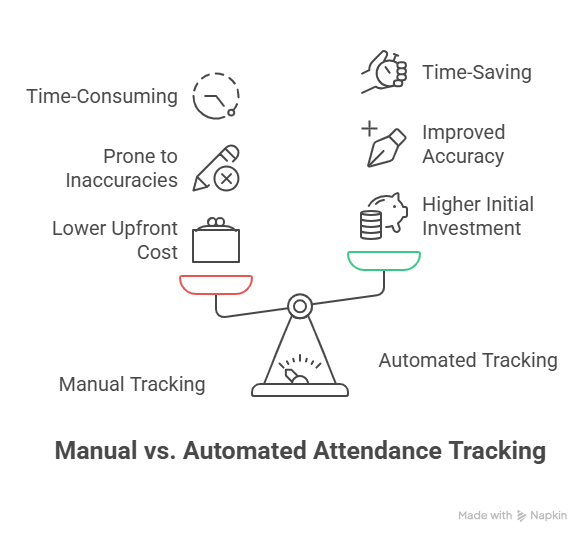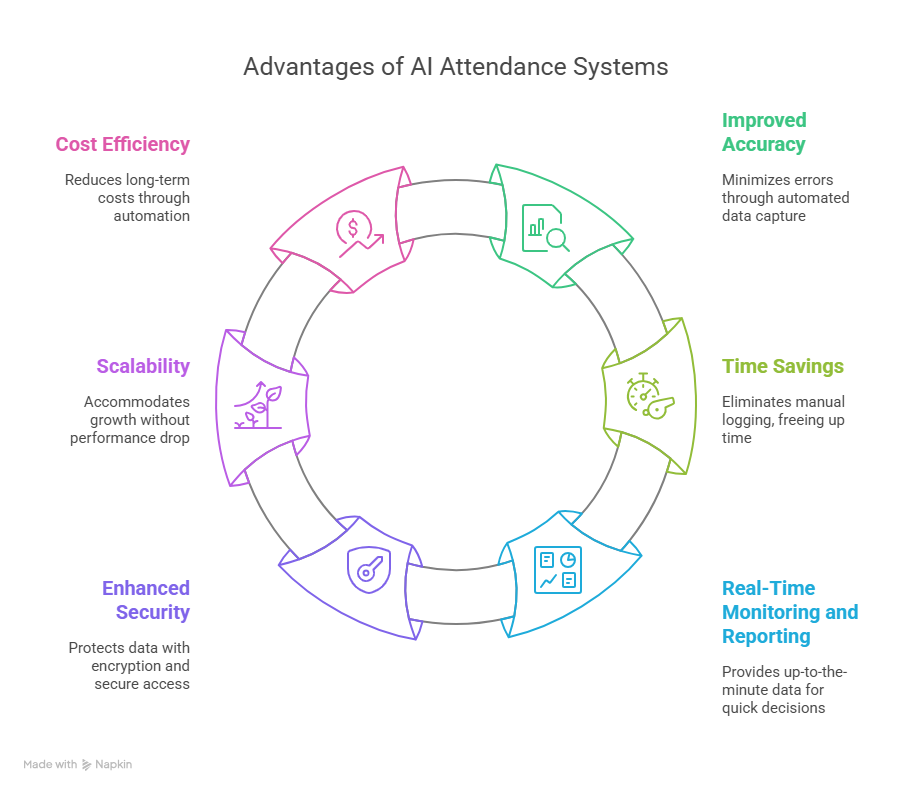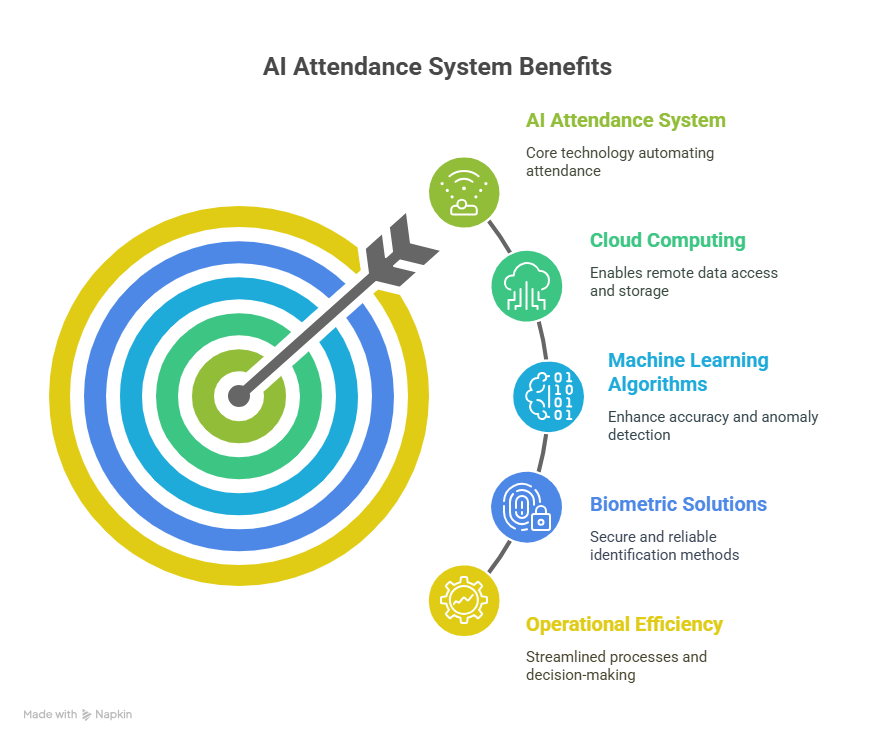
Table of contents
In today’s fast-paced business world, companies need efficient and reliable methods to track employee attendance. AI Attendance systems offer modern, automated solutions that replace traditional manual tracking methods.
What Is AI Attendance?
AI Attendance refers to the use of artificial intelligence technology to monitor, record, and manage employee check-ins and check-outs. AI Attendance systems leverage advanced algorithms, machine learning, and often biometric or facial recognition technologies to ensure that attendance data is captured accurately and in real time. These systems automatically process data, flag discrepancies, and generate comprehensive reports with minimal human intervention.
Businesses that use AI Attendance typically notice enhancements in the accuracy of their data, in the time required, and overall productivity. Businesses eliminate the chance of human error and free up valuable resources to be repurposed for more strategic activities by automating the attendance process.
Understanding Manual Tracking
Manual tracking, however, uses conventional techniques like sign-in sheets, punch cards, or spreadsheets to log employee attendance. In manual tracking, staff have to update and keep records manually on a daily basis. Manual systems are highly dependent on the accuracy of individuals and the dedication of supervisors or administration personnel.

Although manual tracking might cost less upfront, it is accompanied by issues like time wastage, inaccuracies, and complexity in handling large volumes of data. Lost records, human errors, and delays in updating data are typical traps that may result in misreporting and impact payroll, compliance, and workforce management. Even though numerous organizations have been utilizing manual processes for decades, the changing technological environment proves that there exists a better way—one anchored on innovation and automation.
A Comparative Analysis
When comparing AI Attendance and manual tracking, several key factors come into play. The following table breaks down these factors, highlighting the strengths and weaknesses of each method:
| Aspect | Manual Tracking | AI Attendance |
|---|---|---|
| Accuracy | Prone to human error and mistakes | High precision with automated data capture |
| Time Efficiency | Time-consuming; requires manual data entry and updates | Automates attendance logging, saving precious administrative time |
| Data Management | Relies on paper or local digital files that may be misplaced | Centralized, secure, and easily accessible digital records |
| Reporting | Delayed report generation; requires manual compilation | Real-time analytics and instant reporting |
| Scalability | Becomes unwieldy with increased workforce size | Easily scalable with robust cloud-based solutions |
| Security | Vulnerable to data loss and limited security measures | Advanced security features, including encryption and access control |
| Cost Efficiency | Lower initial cost but higher long-term labor and processing costs | Higher upfront investment with better long-term savings and ROI |
This table clearly shows how AI Attendance outperforms manual tracking across multiple facets. The advantages become particularly apparent as companies scale up their operations and require more reliable, real-time data management.
Advantages of AI Attendance

- Improved Accuracy: AI Attendance solutions eliminate human mistakes as data input is automated. Facial recognition, biometric authentication, and other AI-based solutions guarantee that each check-in and check-out is documented correctly. This precision eliminates payroll errors and administrative discrepancies, resulting in seamless operations.
- Time Savings: The Time Savings Automation reduces the time employees or managers need to spend hours manually logging attendance. With AI Attendance, information is captured immediately, allowing staff to devote more time to other critical tasks. This added efficiency enhances overall productivity throughout the organization.
- Real-Time Monitoring and Reporting: Real-Time Monitoring and Reporting AI Attendance systems offer minute-by-minute information on the presence of employees. Real-time analytics allow HR departments to monitor attendance patterns, spot issues immediately, and make well-informed choices. Instant reporting is vital in dynamic business contexts where timely modifications can make a big impact.
- Enhanced Security: Better Security Automated tools provide greater data security than traditional methods. Electronic records are less susceptible to loss or interference, and up-to-date AI tools include encryption and secure access measures. These security measures shield employee sensitive information and enable businesses to comply with standards.
- Scalability: After the implementation, ensure that you have access to ongoing technical support. Regular updates and maintenance are essential to keep the system running efficiently. Evaluate the system periodically to leverage new features and improvements.
- Cost Efficiency in the Long Term: Although the upfront cost of setting up AI Attendance systems might be more compared to manual systems, the cost saving in the long run is substantial. Lower labor hours, fewer errors, and enhanced operational efficiency mean a superior return on investment in the long term.
Challenges of Manual Tracking
Manual tracking, although inexpensive initially, poses several challenges:
- Human Error: Manual entry often leads to mistakes. Misplaced sheets, incorrect entries, and oversight can impact the entire payroll process and create disputes.
- Time-Intensive Processes: Manually updating attendance records takes considerable time, especially in organizations with many employees. This process requires dedicated staff, which can drive up administrative costs.
- Delayed Reporting: With paper-based records or spreadsheets, compiling data into comprehensive reports takes longer. Delayed reporting prevents leaders from accessing real-time insight and hinders quick decision-making.
- Security Risks: Paper records and locally stored files are more vulnerable to theft, damage, or loss. Without proper security measures, sensitive employee information is at risk, potentially resulting in compliance issues.
How AI Attendance Addresses These Challenges
AI Attendance systems bypass the weakness of manual tracking by utilizing technology to automate and safeguard the attendance process. AI Attendance systems make sure that information is captured swiftly, accurately, and securely. New-generation AI Attendance systems implement cloud computing, machine learning algorithms, and biometric solutions to deliver robust tracking. These tools of technology not only reduce errors but also provide HR teams and management immediate access to attendance analytics, thus aiding in rapid and accurate decision-making.

For instance, take a business with 500 workers distributed over several locations. With manual monitoring, continuous surveillance becomes almost unfeasible. In contrast, an AI Attendance system tracks attendance at all sites, alerts abnormalities in real time, and automatically collates performance metrics. This real-time, centralized information makes proactive management and operational effectiveness easier.
Implementing AI Attendance in Your Organization
Transitioning from manual tracking to an AI Attendance system involves several key steps. Here’s a simple roadmap to guide you through the process:
- Assessment of Needs Evaluate your current attendance tracking process and identify the pain points. Determine the specific features you need in an AI Attendance system—accuracy, scalability, security, real-time reporting, etc.
- Research and Vendor Selection Look for vendors that offer AI Attendance solutions tailored to your business size and industry. Compare features, pricing, and customer support. Reading reviews and case studies can help you make an informed decision.
- System Integration Plan the integration process with your existing HR and IT systems. It is critical to ensure a smooth transition to avoid disrupting daily operations. Engage with IT experts to guide the technical setup and ensure data flows seamlessly between platforms.
- Employee Training Introduce your team to the new system through comprehensive training sessions. Explain how the AI Attendance system works, its benefits, and what is expected from each employee. Clear communication during the transition builds trust and eases adoption.
- Ongoing Maintenance and Support After the implementation, ensure that you have access to ongoing technical support. Regular updates and maintenance are essential to keep the system running efficiently. Evaluate the system periodically to leverage new features and improvements.
Conclusion
In short, although manual tracking can appear to be cheap and convenient, it is riddled with inefficiencies and hassles that can undermine the productivity of an organization. AI Attendance systems prove to be the better option by making data capture automatic, improving accuracy, providing real-time reporting, and eventually ensuring security and scalability. With companies further improving and streamlining according to current tech solutions, AI Attendance proves to be more and more essential for seamless workforce management.
Curious Readers may see the reference : Read Here